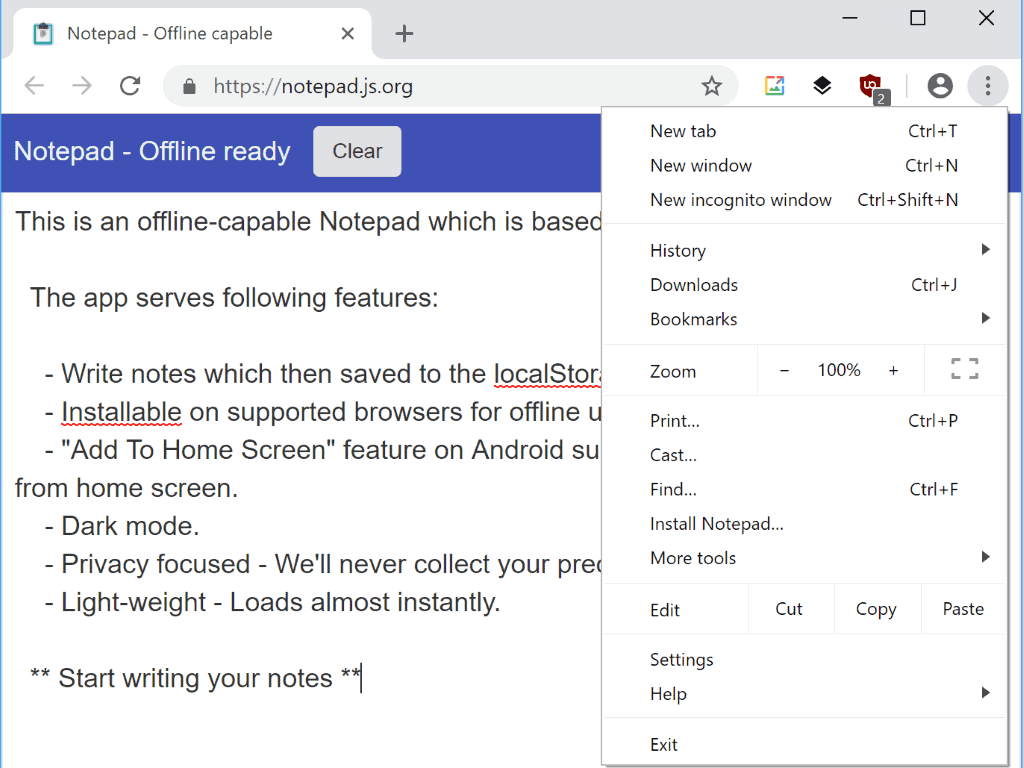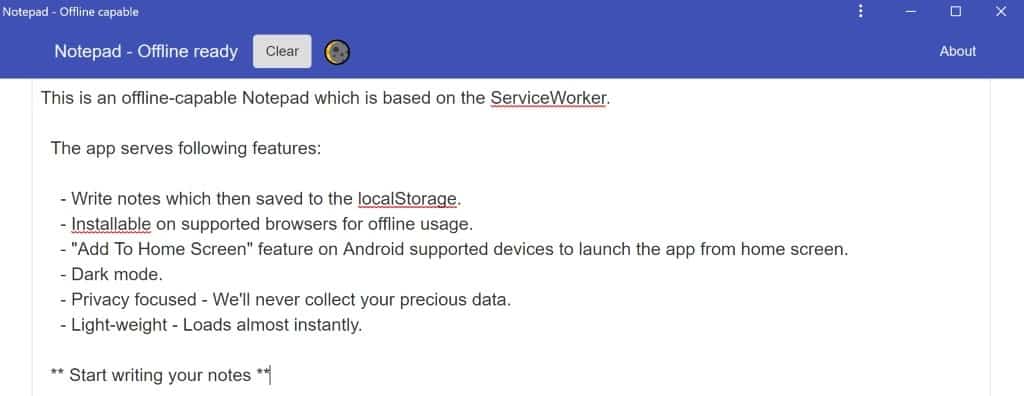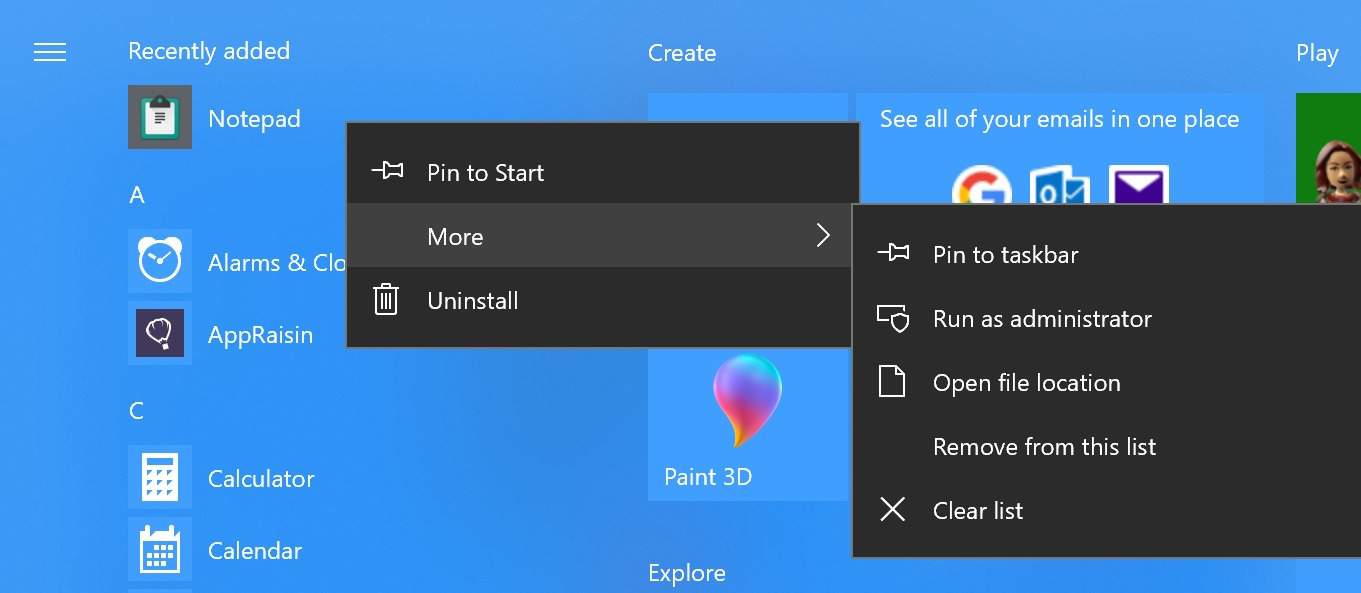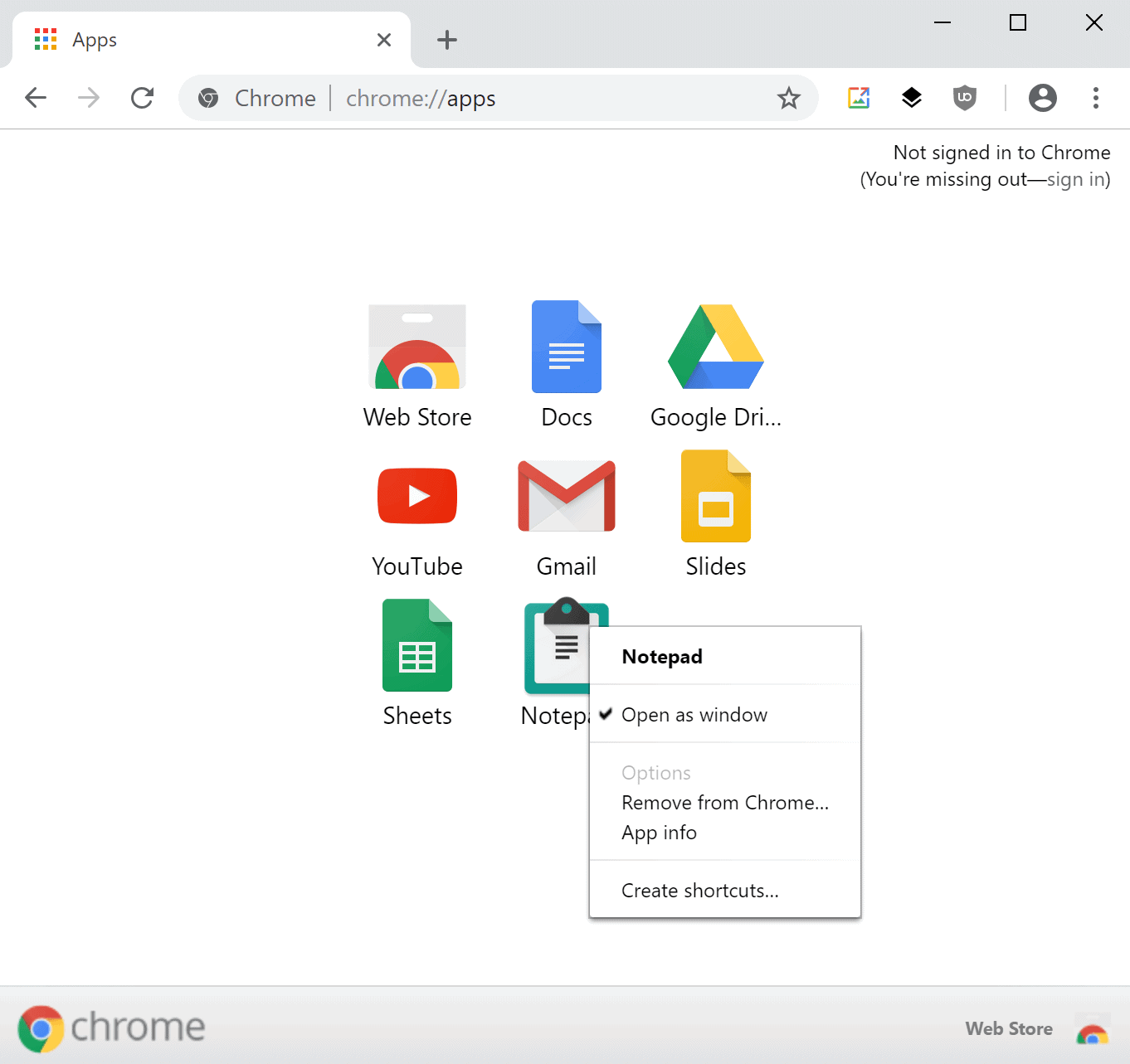How to install Progressive Web Apps in Google Chrome

Google launched a new feature in Chrome 70 that allows users of the web browser to install Progressive Web Apps (PWA) in the browser.
Broken down to the core, Progressive Web Apps turn sites and services on the Internet into something that behaves more like applications. The approach has some benefits, e.g. that users can launch the apps from the operating system's desktop and even use the service offline provided that this is supported.
Offline support depends largely on the application and the functionality that it provides. A Notepad PWA should work fine offline while a service like Spotify or Twitter may not or only in limited capacities as they require access to the Internet to download data to the user device.
PWAs may also use functionality that the operating system provides. On Windows 10 for instance, apps may make use of the notification center of the operating system or follow certain rules and policies.
Note: Linux and Mac OS X users need to enable the chrome://flags/#enable-desktop-pwas policy in the browser by setting it to Enabled. Google plans to add default support for these systems in Chrome 72.
Installing PWA in Chrome

Google integrated Progressive Web Application support in Chrome 70 which the company released in October 2018. The implementation uses the simplest approach possible when it comes to the installation of PWAs.

All Chrome uses have to do is visit a page with a PWA, e.g. this note taking app, and click on Menu > Install AppName to install it.
Chrome loads the application in its own interface afterward and adds it to the operating system's list of installed applications. Windows 10 users find it listed in the Start Menu and can load it from there at any time.

Since it is listed in the Start Menu, it is possible to interact with the app just like you'd do with any other installed program or app.
Right-click on it for options to pin it to the Start Menu or Taskbar, to uninstall the app, run it with elevated privileges, or open its location on the system.
Chrome itself lists installed PWAs as well and provides users with management options. Google made the decision to integrate them with apps in the browser which means that you can display all installed PWA by loading chrome://apps/ in the browser's address bar.

You can launch any installed application with a click or tap on it. The right-click menu displays some options that you may find useful. There you find an option to remove the PWA from Chrome again, create a new shortcut for it, or deselect the "open as window" option to open it in a tab in the active browser window instead.
Chrome and PWA
Chrome's PWA support works out of the box and is as simple as it gets. The biggest limitation of it at this point in time is that Google does not maintain a Store or repository for PWAs yet.
The company could add it to the Chrome Web Store but has not mentioned any plans to do so at the time of writing.
Chrome users who like PWA need to visit the exact URL the PWA is offered on and click on Menu > Install to install it; this leaves two options: either search for PWA manually or use third-party lists like the one on GitHub to get the right links.
Now You: Google adding PWA support to Chrome: useful or dead on arrival?




















Bookmarks and favorites are handy options for saving interesting websites you come across while surfing the web on Android but are far from ideal when it comes to instant access. Thankfully, Google Chrome gives you the added ability to save webpages and progressive web apps directly to your home screen for added convenience.
Installed this app and a few others in Chrome 71… All apps insist on displaying an address bar at the top ! Does not look “native” at all…
Did something changed since this article was writen ? I don’t see the address bar in the demo video…
Maybe not ready for “prime time” ?
Hi,
Great article! PWAs may be installed onto any Windows/Android/iOS/Chromebook platform that supports running the new Chrome 70 browser.
It definitely is capable of installing and running PWAs on Windows 7, which I am running on. At this point only MS Edge and Chrome are capable to support PWAs fully.
As an independent application and software developer this absolutely frees up our software to install and run independently of any App store available on the internet!
It’s absolutely great news!
Our PWA software may be found here:
https://office.ssuiteoffice.com/
https://tv.ssuiteoffice.com/
https://groot.ssuiteoffice.com/
https://blog.ssuiteoffice.com/
Have fun with our absolutely FREE PWA software… :D
If the browser has extensions e.g. for ad-blocking do they remain active on the PWA?
Do you now the Spotify PWA address ?
Fixed it? It’s no longer possible to create webapps from any sites that I need. Sure, it works for some FEW PWAs, many of them aren’t installable that way! Before it worked for any site, without exception. You could decide in general settings if you prefer system titlebar and frames or not. Now it’s all gone. It’s like now 1% of previous functionality with broken settings, so it’s even worse. This is broken as it comes.
I don’t need Spotify PWA if I can install normal Spotify app. But I need Asana webapp because there is no app for that, aside microsoft store which sucks because it is too limited in options. I used SSB for many sites that never had any specific, installable programs. Now it’s all gone. I can’t use them anymore and they are again in a browser’s tab, which is confusing and counterproductive.
Basically, previous Chrome versions allowed to create SSBs (Site Specific Browsers), now it doesn’t. Again, this is broken. It worked well, now it don’t work at all. And the worst thing is, there is no easy replacement for this functionality.
Having able to install just a fraction of PWA’s that don’t interest me is useless. This is a heavy regression :(.
It still creates Site Specific Browsers. The same way it did before. They haven’t removed this option, you still can the same way. Nothing is gone because of the new PWA options. I just created a ghacks app and I am sure ghacks is not PWA.
How? There is no option for it anymore. And the old SSB’s behave now like PWA’s (which isn’t ideal) while new ones are merely shortcuts.
I can’t install ghack as webbapp nor any of the websites I want.
As far I know, others have the same issue so how it is possible you can do that? I need old functionality.
Can you make a video or screenshots? Thanks!
I agree. This is incredibly frustrating to me. I can’t believe they’ve done this. I used this functionality for many sites on a daily basis. I simply don’t understand why it was necessary to break something so useful.
I finally found out how to create SSB’s now. The functionality still exists and is not broken. The only problem with it is this new browser’s titlebar (SSB’s now can’t use system titlebar).
Go to a site which you want to turn into SSB and go to ->More tools-> Create a shortcut
Then open a tab with:
chrome://apps/
Find the new site and right-click on it and mark “Open as window”
Now the new site will have its own starter, icon, and window.
This is incredibly convoluted and not discoverable way of doing it…
Thanks Mike. It’s a relief that it’s still available. They do seem to have moved/hidden it.
This is truly horrible what they did.
Chrome/Chromium had the option to turn ANY website into webapp and I was happily using this feature for a long time. With new version 70 they broke it completely. Not only I cannot install any sites, apps, but even many PWA can’t be installed. For example, Google Maps – no option showed up and so on.
From perfectly functional and great feature we have now completely useless and rarely working equivalent… All installed apps have non-system titlebar and won’t follow general Chrome/Chromium settings which makes it difficult to use and style. Old webapps were replaced with simple shortcuts so we open either only a new tab or a new window with given app, which gives no benefits.
I’m so unhappy. Something that worked so well was destroyed and we were given a very poorly designed and incredibly limited knock-off. :(
You can drag the URL to the Apps page chrome://apps/. From there you can right click on it, tick “Open As Window”, and then choose to save to desktop and/or Start menu. Took me a bit to find it, but it is still there.
They haven’t broken anything.
I just created 2 new normal WEBAPPS on Chrome 70.
I created a Spotify webapp too, even if a PWA is available.
And it’s great and awesome that webapps now don’t use the system titlebar and fit nicely with the webpage.
The best and greatest new feature of webapp creation in 70.
I’m so happy for Chome 70. It works better that ever, so glad they finally fixed webapps.
Google is so progressive,wait didn’t they already have chrome apps?Then they scraped them on desktop,except chromebooks,now they reintroduce them again,but they are progressive now,get it,everything must be progressive these days;)!Sheesh,google creates and scrapes projects more often then I change my underwear,they just can’t seem to set it and forget it!
ok, for example:
https://outweb.io/
= currently everything you really don’t need; crap for short. of course at the moment this also applies to the windows store, by the way.. .
You can also pin the Notepad app linked in the article to the taskbar in Edge.
I read the word “progressive” and I run. Sorry. Couldn’t read this article, Martin.
@James: I hope you don’t run out of your optician’s office when progressive multifocal lenses are mentioned as an alternative to bifocals or trifocals. Although, on second thought, if you only ran out after the price tag for some of the fancier versions was mentioned, I’d understand. ;-)
Good response.
Do any other browsers support these? Good die or bad idea, I wouldn’t worry about it being an attempt by Google to essentially take over any operating system Chrome’s web browser is installed on with Chrome-only pseudo applications/programs *if* I heard that Firefox and some other browsers without the Webkit/Blink engine could use them, too. I’d still worry about the potential death of native programs/applications that can operate well in the absence of an Internet connection, but at least it wouldn’t be forcing people into a monopoly browser.
With Windows going to the software as a service model and Chrome doing this combined with increased Chromebook series, I increasing worry about “PCs” becoming thin clients that rely almost entirely on the Internet. You know, you can’t even buy an off-line encyclopedia anymore as far as I know, at least not as a computer program. There’s something where you can download and convert a dump of Wikipedia without pictures of graphs and use that in a program (WikiTaxi) that provides functionality like that (an off-line encyclopedia), which is cool, but it’s there because of areas in some third-world countries where Internet access is hard to come by, and may not continue when the Internet is more ubiquitous worldwide.
Don’t get me wrong, I live the Internet. I just like all my devices, including my PC and my phone, to have a wide range of apps that don’t require the use of the Internet so that I don’t have expensive bricks if my Internet services goes down for maintenance or because of storm damage or travel or whatever, or a missed bill.
If Google actually has got these webpages providing a proprietary Chrome-only web app, that adds a whole new dimension to the thing that is bad in it’s own way beyond just the above. When Chrome launched, Google promises us it was just to try to push other browsers into staying current and adopting new technology. Then it became the world’s leading web browser by market share, and we started to see Chrome specific HTML markup, sites that only work on Chrome, and so on and so forth. Even some Google pages and services seem to fail to operate or operate as well in certain other browsers (I suppose that’s not surprising, but it shows that it’s not just third-parties reacting to Chrome’s marketshare, but Google itself that’s encouraging Chrome to abuse it’s monopoly* powers and limit user choice). It’s turning into the new Internet Explorer 5, which is bad for consumers, who will eventually lack real choice and web browsers that innovate in different ways if they want “full” access to the Internet, which is really bad in the long run, as anyone who remembers those days can attest to.
* Something doesn’t have to have 100% marketshare to be a monopoly. That’s a myth. It probably stems from the fact that when one explains or teaches someone what a monopoly is, the easiest example to use, for the sake of simplicity, is a company with 100% marketshare in a given area. Actually, though, a company can be a monopoly without literally being the only thing that does what it does, if the market sees it as pretty much the only thing that can do what they expect and everyone knows they have to cater to it’s eccentricities and can basically ignore competitors, and it has the power to unilaterally alter an ecosystem to it’s own benefit, and against the benefit of competitors or potential competitors or consumers, because of it’s large market share.
You worry about the potential death of native programs/applications that can operate well in the absence of an Internet connection, but at least it wouldn’t be forcing people into a monopoly browser? First of all these kind of apps work with no internet connection. Second of all, chromium is open source and they will work there too. And they will also work on every operating system and won’t be locked as “windows only apps” or “android only apps”.
Hey guys! Thanks a lot for featuring my app in this article. This means a lot! :)
Starting from Chrome 70, it looks like the browser is ignoring the Cookie Jar Consistency flag even when it’s disabled. What a pain in the butt!
With Chrome, Google is aiming to become the dominant operating system. Operating systems is a tough market to break in to, but Google took the approach of making a browser and then pushing towards browsers to become the new host for applications. They’ve succeeded somewhat. Chrome is way to dominant today. Much like IE back in the day.
That’s not so much Google’s effort as a natural progression.Think about “NetPCs” (90s) or Tim O’Reilly’s concept of the “internet operating system” (2000s).
All I need my browser to do is display text, images and videos from websites. I can take care of the rest. If it wasn’t insecure I’d go back to using Firefox v3.